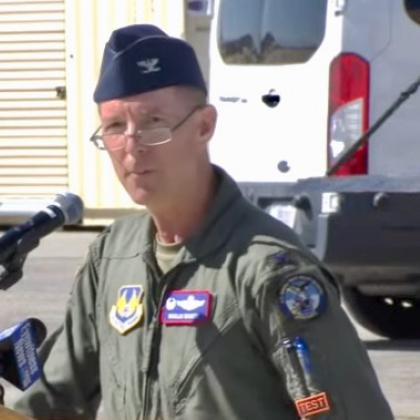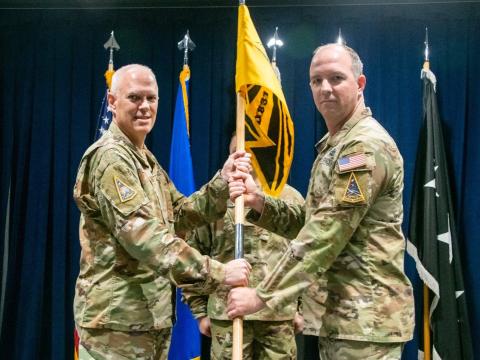Air Force Accepts Delivery of First Flying Orb
After several years of development stemming from a program kick-off during the height of the pandemic, the U.S. Air Force’s Agility Prime effort—part of the service’s innovation arm of AFWERX—has delivered on its promise of ushering in electric vertical takeoff and landing, or eVTOL, capabilities.
Created in 2020, the Agility Prime program heavily pursued, with vendor partners, the manufacturing of eVTOL aircraft and related technologies to create a new class of air mobility systems within three years. The program supported Federal Aviation Administration (FAA) certification and Air Force airworthiness development, as well as helping to build an ecosystem for the flying orb market. With the military backing, the program reduced risk and demonstrated industry opportunities in the military and government as a leader in the autonomous air race.
The delivery to the service by Joby Aviation on September 25 of the first eVTOL to Edwards Air Force Base represents a significant milestone, leaders said during the broadcasted ribbon-cutting ceremony that displayed the Joby eVTOL aircraft and the new hangar for VTOL tactical maintenance and testing for the 412th Test Wing, who will be leading the flight test campaign.
“We are here starting a new chapter in the rich heritage of Edwards Air Force Base, testing and evaluating new capabilities for both the warfighter and greater industry,” said Maj. Philip Woodhull, commander of the Emerging Technologies Integrated Test Force (ET-ITF) at the 412th Test Wing at Edwards. “From the first sonic boom to hypersonic speeds, Edwards remains at the pinnacle of air-space achievement. The ET-ITF will be leading the flight test campaign for Joby and Agility Prime here at Edwards. This partnership between AFWERX, Agility Prime and the ET-ITF is a new, direct, agile path to progress technology through the acquisition Valley of Death.”
“Today's delivery of a Joby aircraft to Edwards Air Force Base marks the culmination of seven years of a very significant public-private partnership between Joby Aviation and the Department of Defense,” said Paul Sciarra, executive chairman of Joby, who also was a co-founder and CEO of social media site Pinterest. “It's a partnership that over time has extended across a wide range of stakeholders, including the Defense Innovation Unit, AFWERX, Agility Prime, NASA, the Air Force, the Marines and many others. The early interest that the DoD showed in Joby's capabilities had a profound impact on our company and, from my perspective, on the future of electric flight here in the U.S.”
Joby’s delivered eVTOL aircraft is designed to fly 100 miles on a single charge at speeds up to 200 miles per hour. It can carry four passengers plus a pilot and 1,000 pounds of payload. “It has fewer parts than a helicopter and no single points of failure,” Sciarra said. “The fly-by-wire unified flight controls are really modeled on those of the F-35 B and make it very simple to fly.”
In addition to Joby, several companies are working with the service to produce VTOL aircraft, including Archer Aviation, BETA Technologies, Elroy Air, LIFT Aircraft, Moog Aircraft Group and Kittyhawk.
The service sees many use cases for eVTOL aircraft, including personnel movement, cargo transportation, personnel recovery, logistics under attack, rapid aircraft maintenance, urban mobility, disaster response, base operations and support, communications relay, missile field support, emergency response, test support, training, range, support, and search and rescue.
“And I'm looking forward, as Joby works to change the way that we live our lives through transformative vertical lift, we will be side by side changing the way that we defend our nation and serve our country,” said Col. Elliott Leigh, director of AFWERX and chief commercialization officer for the Department of the Air Force. “I look forward to the partnership and the progress that we have to come.”

We are literally standing on the threshold here of a new era in aviation.
Meanwhile, NASA, as part of its Advanced Air Mobility mission, will have shared access to the eVTOL aircraft for NASA’s Armstrong Flight Research Center, which is located at Edwards, said Wayne Ringelberg, chief pilot at Armstrong. NASA has a long-standing alliance with the 412th Test Wing, which, through the interagency agreement with AFWERX, will allow NASA to have hands-on experience with the emerging technology.
“Armstrong Flight Research Center has a long history of supporting important technological milestones in aviation and in space, including supersonic and hypersonic flight…. and also continued support of NASA's Artemis mission to return us to the Moon and on to Mars,” Ringelberg said. “But we also have a history with several of the partners here today. Joby Aviation partnered with NASA on its National Campaign project. We were able to look at the acoustics of these emerging electric air taxi vehicles. We also got access to their fairly high-fidelity simulator to do some airspace integration testing.”
For the most part, NASA’s testing of the eVTOL will focus on how the aircraft can fit into existing airspace for everyday use. “We'll get a firsthand understanding of how these kinds of aircraft fly, and that understanding will inform our research in several areas to help support this emerging technology, including for air traffic management, how these aircraft will integrate into current airspace structure,” Ringelberg noted. “And what kind of ground-based infrastructure we might need and also to help inform standards for how we can certify these vehicles.
“We certainly are committed to equitable sharing, and I'm sure AFWERX is as well committed to the equitable sharing of resources to advance the technology for the benefit of the U.S., the DoD and the public,” he said. “So, let's go fly.”





Comments